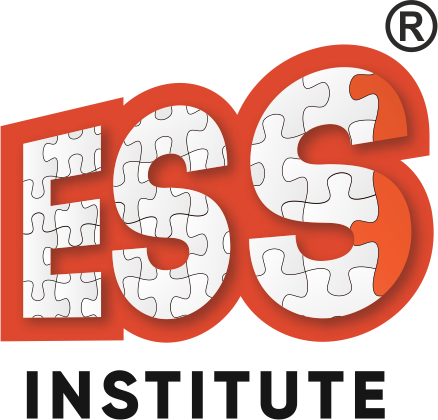Have you wondered why all of a sudden most coders, programmers, or engineers are switching to Python? Are you someone who wants to learn python because of its popularity and application in all areas and industries? Then you are at the right place. The article will help you to start your python journey.
Pre-Requisite:
- The machine can not directly understand the code and hence it requires to be converted into machine readable language.
- Interpreter: The interpreter converts the program code into machine-readable code, instruction by instruction
- Library in Programing language: In any programing language, a library refers to a collection of files, codes, functions, and programs. These libraries help the user by allowing him/her to import for reusing the code and act as references in a program code
What is Python Programming Language
Python is an open-source object-oriented high-level programming language developed by Guido van Rossum in 1991 and presently owned by Python Software Foundation (PSF).
Based on the highly interactive programing language that offers an environment for personal programming called ABC language influences python language a lot.
To understand python in a single statement, Python is a general-purpose programming language that can be used effectively to build any kind of program independently without any direct or indirect dependence to any operating system or platforms
Major Features of Python
- Python is interpreted, interactive, and directly executed, with pre-compiled code. It means that it is processed at runtime by the interpreter and you need not compile the program before execution.
- Loosely typed Object- Oriented programming language with few keywords (reserved words) and simple English – like foundation and structure, and is easy to learn.
- Free open source and portable language having a large repository of libraries.
- It supports GUI (Graphical User Interface) and Garbage collection ( better memory management)
Benefits of using Python for programming
Apart from the above salient features, Python offers the following advantages:
- Platform-Independent: Platform-independent programing language that runs across different platforms like windows Linux / Unix Mac OS X and other operating systems.
- Readability: Python programs use clear, simple, concise, and English-like easy-to-read instructions. Python can be easily understood even by non-programmers or people which no substantial programming background
- Higher Productivity: Being a simple language with small codes and extensive libraries python offers higher productivity to programmers than languages like C++ and Java. So, users write less and get more tasks done.
Application of Python
Python being one of the most effective programming languages makes it so popular that almost all the domains use python nowadays for:
- Data Science & Data Analytics
- Marketing
- Artificial Intelligence & Machine learning
- Web Application Development
- Scientific Application
Python is used by Google search engine YouTube etc. It is been widely used for system programming GUI programming, internet scripting, web scripting, gaming, text processing network programming, commercial robots, and in space and scientific applications.
How to install python
Several versions of python have been released till now, beginning with Python 1.0 shall be working on Python 3.6.5 before we start working, Python needs to be installed on your system. To install python, you must first download the installation package of the required version from the official website Python.org based on the operating system you use
- Download installer from the official website given above
- Run the setup
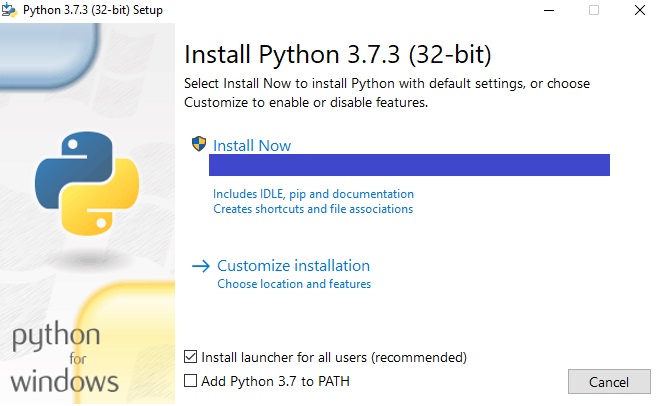
- Either install with default settings or you can customize the installation by choosing so
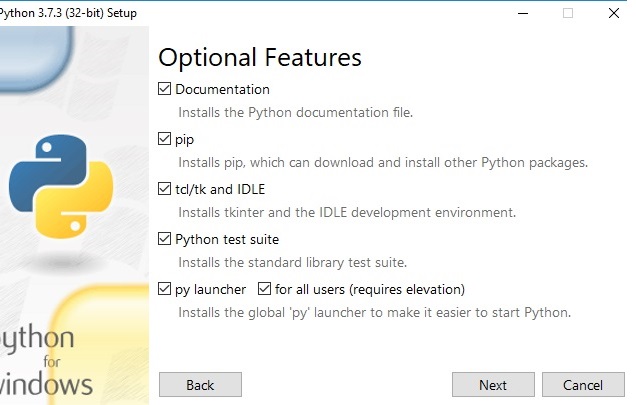
- Just go next and install Python and a success message appears when installation gets completed
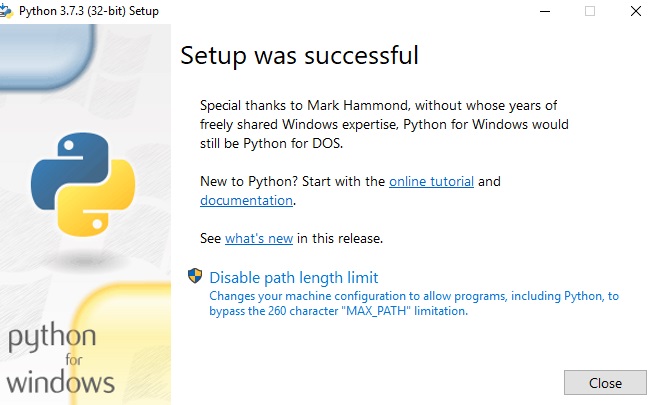
Interacting with Python (Python IDLE)

As a flexible, dynamic, powerful language, Python offers different ways to use it. So users interactively use it simply to test a code or statement line by line or while exploring its interface.
To write and run Python programs interactively one can either use the command line window or the IDLE. IDLE refers to a simple integrated development learning environment that comes with Python. The most important feature of IDLE is that it allows the user to edit python programs from a single interface
Python shell

When you first start Python IDLE by clicking on its icon created on the desktop or menu item on the START menu -> Apps by name -> IDLE (Python 3.6) option, it always starts up in the shell.

Python shell offers an interactive window where users can type in the python code and see the output in the same window. It acts as an interface between Python commands and the OS.
Python IDLE comprises Python shell (interactive mode) and Python editor (script mode).
On opening, the Python shell shows a welcome message displaying its version and a copyright notice. After this the command prompt (>>>) followed by a blinking cursor gets displayed which indicates that IDLE is now ready to take Python commands from the user.
The Python shell, part of Python integrated development environment. The three greater-than signs (>>>) are called the prompt or Python command prompt.
Command line Interaction
When commands are entered directly in IDLE from the keyboard, the Interpreter / IDLE is said to be in interactive mode. In interactive mode, type the command “Hello World” in front of the prompt (>>>) and press enter.
Python is a case-sensitive language.
This means that Python differentiates between capital and small alphabets. For example, Print (P capital) and print (p small) are two different things for Python. Whereas print invalid command in Python print is just awarded and not a command will stop this can be observed by typing the command print (” Hello World”) Python will not be able to interpret and will show an error.
More About Python Shell
The Python Shell window comprises drop-down menus and a Python command prompt (<<<) where you can type or enter statements or expressions to be executed. It is quite different in comparison to others in the way that it allows to scroll back to previous commands to cut, copy and paste earlier commands/statements and to modify them.
The Python Shell window has the following menu items: file edit, shell, debug options windows and help
The shell and debug menus are useful when creating larger programs. The shell menu allows you to restart the shell or search the shell’s log to trace the most recent reset. The debug menu provides useful menu items for debugging the Python program in order to trace errors while checking for line-by-line execution of the entered Python statements.
The options menu allows the user to configure IDLE according to suitability and working requirements.
Python Editor Window (Working in Script mode)
Till now, we were working with the interactive mode where there is no provision for holding or saving the commands that we type that the Python prompt, all these commands along with their output, get cleared as soon as we close the shell window. This limitation can be overcome by working in the python script mode where we can save the commands we are typing. This switchover is carried out through the Python shell itself.
The file window option provides various options to create a new file open an existing file open a module, and save the current modules/session.
When you click on the new file option a new window gets open the python script mode or Python editor window which is a simple and standard text editor where you can type or edit your code.
At the time of its opening, this file is named ‘untitled’ by default, this name can be changed by the user by renaming the file.
Our next step is to save this file by clicking on the file menu -> save as option, followed by typing a proper name for it in lieu of the default name “Untitled”.
if you forget to give the extension.py or.py while saving your file for the first time the Python compiler automatically gives the extension along with the file name.
More about the script mode
While working in the script mode when you enter the statements to be executed and press enter key, you won’t automatically see the results the way you would see in the interactive mode. To see output from a script mode you have to run this script and the print () function.
Exiting python
In order to exit the Python command prompt click Ctrl + Z and press enter key or type quit() or exit(), function/statement, and press enter key.
Your first Python Program
Unlike in other programming languages like C/C++ or even Java where you are supposed to write multiple lines of code just to print your first program, in Python you just need to write the following command in IDLE
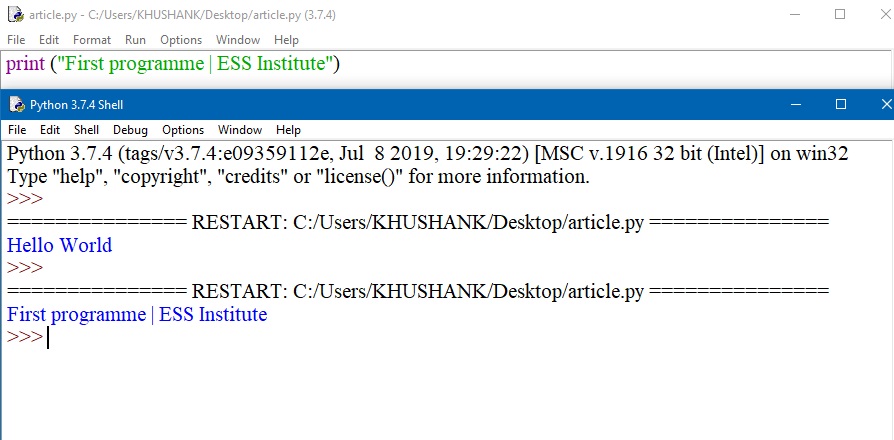
print (‘First Python Code!’)
- Save it and run, you can see the output of the code
- Print command in python just displays a message you have sent between brackets
- Press f5 to run or run by navigating through the menu
What are Libraries in Python?
Python has produced a number of open Source libraries each with its own root Source. A library is a previously combined set of code scripts that may be utilized iteratively to save time. Now, in contrast to languages such as C++ or C, python libraries are not context specific. A library here refers to a collection of essential components or we can say a collection of modules that can be installed with the help of a package manager such as PIP. As of now, we have got some idea about what libraries are. Let’s take a closer look at some of the most popular libraries in Python. We have listed here a few of them.
- “Numpy” is an open source python Library used for scientific Computing and data analysis. It provides powerful numerical and mathematical functions that enable efficient computation of large multi-dimensional arrays and matrices. It is considered as an essential library for data manipulation and Analysis in fields such as machine learning, image processing and scientific Computing. Some of the key features of Numpy include multi-dimensional arrays. It provides a powerful N- dimensional array object that can be used to store and manipulate large data sets. It provides a wide range of mathematical functions that can be applied to arrays and matrices as well including linear algebra, Fourier transforms and random number generation. Numpy is widely used library in a data science and machine learning communities and is often used in conjunction with other libraries like pandas, scikit-learn and tensor flow.
- “Pandas” is an open source data manipulation and Analysis library for the Python programming language. It provides easy to use data structures and data analysis tools for handling and manipulating structured data. It provides two main data structures which are series and data frame. Series is a one dimensional label array that can hold any data type while the data frame is a two-dimensional label data structure with columns and potential of different data types. Pandas provide tools for cleaning, filtering and transforming data such as filling missing values, removing duplicates and replacing values. It provides powerful tools for manipulating data such as grouping, merging and reshaping data.
- Pandas integrate with other popular libraries such as numpy, scipy and scikit-learn to provide a complete data analysis and machine learning environment. “Pandas” is widely used in data science and analysis and are particularly useful for working with tabular data such as data in CSV and Excel files.
- “Matplotlib” is a python Library used for data visualization and provides a wide range of tools for creating graphs plots, charts and other visual representation of data. It is a highly customizable library that allows you to control every aspect of visualization you create. Here, you can customize the style, color, and size, appearance of elements such as lines, markers, access, titles and legends. It also offers several types of plots including line plots, Scatter Plots, bar plots, histogram plots, pie chart and many more. This is built on top of numpy which makes it easy to work with arrays and other numerical data. It also integrates well with other python libraries such as pandas for data manipulation Scipy for scientific Computing and c-bond for statistical data visualization.
- “Scikit-learn” also known as “sklearn” and is a popular open source machine learning library for python. It provides a wide range of algorithms and tools for building and evaluating machine learning models. Scikit-learn are built on top of numpy scipy and matplotlib which makes it easy to integrate with other scientific Computing libraries in Python. It also provides a comprehensive set of tools for various machine learning tasks such as classification, regression, clustering, dimensionality reduction, model selection and pre-processing. It includes popular algorithms such as decision trees, random Forest; support Vector machines, logistic regression, K nearest neighbors and many more. Scikit-learn provide a consistent API for all algorithms making it easy to switch between different models and algorithms. It provides a wide range of pre-processing tools for cleaning and transforming data such as scaling, normalization and feature extraction.
- Scrappy is one of the most popular fast open source web crawling frameworks written in Python. It is commonly used to extract data from web pages with the help of selectors based on X-Path and talking about its application Scrappy helps in building crawling programs that can retrieve structured data from the web. Scrappy is also used to gather data from APIs and follow don’t repeat yourself principle in the design of its interface. Influencing users to write universal codes that can be reused for building and scaling large crawlers.
This is how you can start your journey with Python, learn, get skilled and work on projects, and enroll in the best Online course for Python by ESS institute in Delhi. You can also enroll yourself in the offline python training in Dwarka, Delhi
